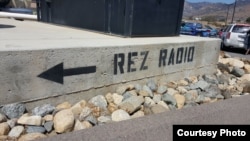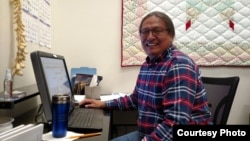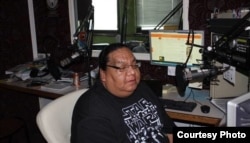Never in a million years did Tom Eagle Staff, a member of the Cheyenne River Sioux Tribe and a retired federal worker, imagine he’d end up a broadcast executive. But if everything goes according to plan, on July 1, he’ll be in charge of the reservation’s first commercial radio station.
The Cheyenne River Reservation encompasses two counties and more than 1,400,000 acres of tribal trust land. The only available radio is KLND, broadcasting out of Little Eagle on the Standing Rock Reservation, about an hour and a half north. But KLND’s signal doesn’t reach all of Cheyenne River, which means some of its residents are not served by radio at all.
“Our tribe had been working with KLND for about 10 years, trying to get some of our sports and community events broadcasted by them,” said Eagle Staff. “But they went off the air a couple of times, and when they got back on, they couldn’t get up to full power.”
Then, in 2010, the U.S. Federal Communications Commission (FCC) established a Tribal Radio Priority to make it easier for tribes to obtain broadcasting licenses and frequencies. It occurred to Eagle Staff the reservation might be able to have a radio station of its own. He approached a local foundation that hands out seed money to new businesses.
“They said, ‘Well, why don’t you do a feasibility study?’ And that’s how I got involved,” Eagle Staff said, laughing.
The FCC granted Cheyenne River its broadcast license and FM frequency last November. Now, the tribe is waiting for a final construction permit that will allow it to erect a transmitting tower.
“Then all we have to do is get all the equipment installed in our studio and we’ll get fired up and connected, hopefully by July 1st,” he said. Then he laughed, adding, “And that’s a very optimistic schedule.”
A solid voice
Cell phones and satellite radio may have eclipsed radio in urban centers, but in rural communities, radio may be the only means of getting critical news, information and entertainment. For tribes, it’s a critical means of preserving a culture, perhaps even saving lives.
“There are 567 Native Nations in this country, and so far, we have 60 radio stations that are licensed either to the tribal governments or tribal communities,” said Loris Taylor of Arizona’s Hopi Nation. She is president and CEO of Native Public Media, which represents the media interests of Native America through legacy and new media technologies, and played an important role in helping to establish the first FCC Tribal Priority for broadcasting.
Radio is particularly important on rural reservations where many tribal members live “off the grid.”
“That means that many services that we take for granted in cities and towns that are wired and connected to the larger internet are not available, like cell phones or 911,” she said. “We are beginning to see a lot more weather-related incidents across Indian Country, and when those disasters and emergencies occur, native radio is a solid and often the sole voice.”
Bad jokes and chickadees
It’s early morning in Callaway, Minnesota, about 400 miles east of Cheyenne River. Inside the studio's of radio KKWE NiiJii on the White Earth Indian Reservation, DJ Terry Goodsky reads a selection of “bad jokes,” a daily feature on his “Talking with Terry” show.
“What’s a tree’s favorite beverage?” he asks. “Root Beer,” he answers, groaning and chuckling. “Why was there thunder and lightening in the laboratory? The scientists were brainstorming.”
Goodsky, an enrolled member of Minnesota's Bois Forte Band of Chippewa Indians, plays music ranging from popular hits to Native rap and pow-wow songs – and a “Word of the Day” segment: Gaas gosh ka na shii, “chickadee.” It’s one of the ways that Niijii radio helps efforts to revitalize the Ojibwe language, which UNESCO lists as “severely endangered.” Today, only about 1,000 Minnesotan Ojibwe still speak the language, most of them over age 70.
Other station programming includes “Gichi Aya'aag Bizindaw ya,” which translates roughly as “Listen to Your Elders,” in which senior tribal members share personal and cultural histories.
White Earth is a small reservation comprising about 1,000 acres. That means Niijii Radio reaches populations outside reservation borders.
“One of the things that I have found in my time working here is that it really helps to build relationships with the non-Native communities,” said General Manager Margaret Rousu. “When you think about a marginalized population and the stereotypes that go with it, this has been an opportunity to educate people about who we really are as Ojibwe people.”
Niijii Radio relies entirely on funding from the State of Minnesota and the Corporation for Public Broadcasting (CPB).
CPB is a private, nonprofit corporation that receives almost all of its funding, about $445 million, from the U.S. government and distributes those funds as grants to non-commercial television and radio stations and their programs. Out of the 60 native radio stations in the United States, about 35 rely on CPB funding and local donations.
This week, President Donald Trump proposed huge cuts in government spending, including the Corporation for Public Broadcasting.
But converting to a commercial station like Cheyenne River is not an option, added Niijii Radio Program Manager Carlee Kuhn.
“Think about the area we live in,” she said. Roughly 44 percent of White Earth’s Ojibwe live at or below the poverty line, and close to half of its adult population are unemployed. “If we lose CPB funding,” said Rousu, gloomily, “that’s it. We’ll just shut down.”










